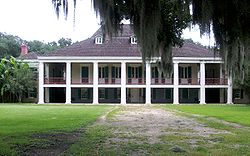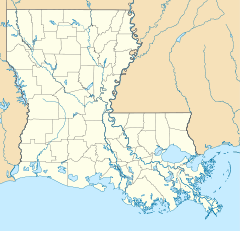- Destrehan Plantation
-
Destrehan Plantation
 Destrehan Manor House
Destrehan Manor HouseLocation: River Rd. (LA 48), Destrehan, Louisiana Coordinates: 29°56′43″N 90°21′55″W / 29.94528°N 90.36528°WCoordinates: 29°56′43″N 90°21′55″W / 29.94528°N 90.36528°W Built: 1787–1790 Architect: Paquet,Charles Architectural style: Colonial, Greek Revival Governing body: Private NRHP Reference#: 73002132[1] Added to NRHP: March 20, 1973 Destrehan Plantation is an antebellum Greek Revival house located near Destrehan, St. Charles Parish, Louisiana. In the nineteenth century, the house was the center of a bustling slave plantation that produced sugar for export. The site hosted the notorious St. Charles Parish Tribunal, which executed 18 of the slaves involved in the 1811 German Coast Uprising, the largest slave revolt in American history.
The house is a unique example of a plantation home outliving the oil refinery that had been built around it. It is listed on the National Register of Historic Places for its architectural quality and association with important people and events in Louisiana history.
Contents
History
One of the oldest homes in the Louisiana Purchase, Destrehan Plantation was constructed beginning in 1787 and completed in 1790. Robin de Logny contracted with a free man of color, Charles Pacquet, to build the house and outbuildings to support his indigo plantation. Pacquet was given the use of six slaves to build the house. He was paid the grand sum of "one brute negro," a cow and a calf, 100 bushels of both corn and rice, and $100 in cash upon completion. This building contract, still on file at the parish courthouse in Hahnville, LA, makes Destrehan Plantation the oldest documented house in the Lower Mississippi Valley.
Under the ownership of statesman and planter Jean Noel Destréhan, the plantation became the leading sugar producer in St. Charles Parish in 1803. Later owners included Scotsman-turned-millionaire Stephen Henderson and Judge Pierre Adolphe Rost, who served on the Louisiana Supreme Court from 1845 to 1853. The plantation remained in the family until 1910 [2]
1900s
In 1914, the Mexican Petroleum Company bought the property and built a refinery. Subsequent owners were Pan American Southern Company and American Oil Company, which closed the refinery in 1959.
The following twelve years brought rapid decay for Destréhan Manor. Thanks to an old legend that the illustrious privateer Jean Lafitte had hidden treasure in the house, treasure-seekers left gaping holes in the walls. Vandals also stripped the house of its Italian marble mantels, cypress paneling, Spanish tiles, and window panes. Fortunately, a local sheriff prevented the theft of the plantation's original 1840s iron gates and a 1,400 lb (640 kg) marble bathtub, rumored to be a gift from Napoleon Bonaparte to the family.
River Road Historical Society
In 1971, American Oil donated the house and 4 acres (16,000 m2) of land to the River Road Historical Society. Through its all-volunteer efforts, the society has raised sufficient funds to halt the process of decay and has begun to restore the house and grounds.
Recent restoration efforts have focused not only on renovating the manor house, but also on recreating the plantation community that surrounded the big house.
2000s
In 2005, the restored house suffered minor damage to the roof and several window panes from Hurricane Katrina. The house was not flooded. Winds toppled three small trees on the property, but the massive live oaks did not sustain any damage.
Modern day
Destrehan Plantation is open seven days a week for guided tours which interpret the lives and lifestyles of the plantation's former residents—both free and enslaved. Demonstrations of period crafts like dying with indigo, candle-making, and open-hearth cooking are performed six days a week.
References
- ^ "National Register Information System". National Register of Historic Places. National Park Service. 2008-04-15. http://nrhp.focus.nps.gov/natreg/docs/All_Data.html.
- ^ Cizek, E.D., Lawrence, J.H., and Sexton, R, 2008. Destrehan: The Man, The House, The Legacy. Destrehan, LA: River Road Historical Society.
External links
- official Destrehan Plantation website - has more information about current operations
- Louisiana State Museum Map Database, Destrehan Plantation
- Michael F. Knight, "The Rost Home Colony, St. Charles Parish, Louisiana", Prologue Magazine, National Archives
- Freedmen's Bureau, LA - Rost Home Colony
Categories:- National Register of Historic Places in Louisiana
- Plantations in Louisiana
- Historic house museums in Louisiana
- Museums in St. Charles Parish, Louisiana
- Greek Revival architecture in Louisiana
- Antebellum architecture
Wikimedia Foundation. 2010.

